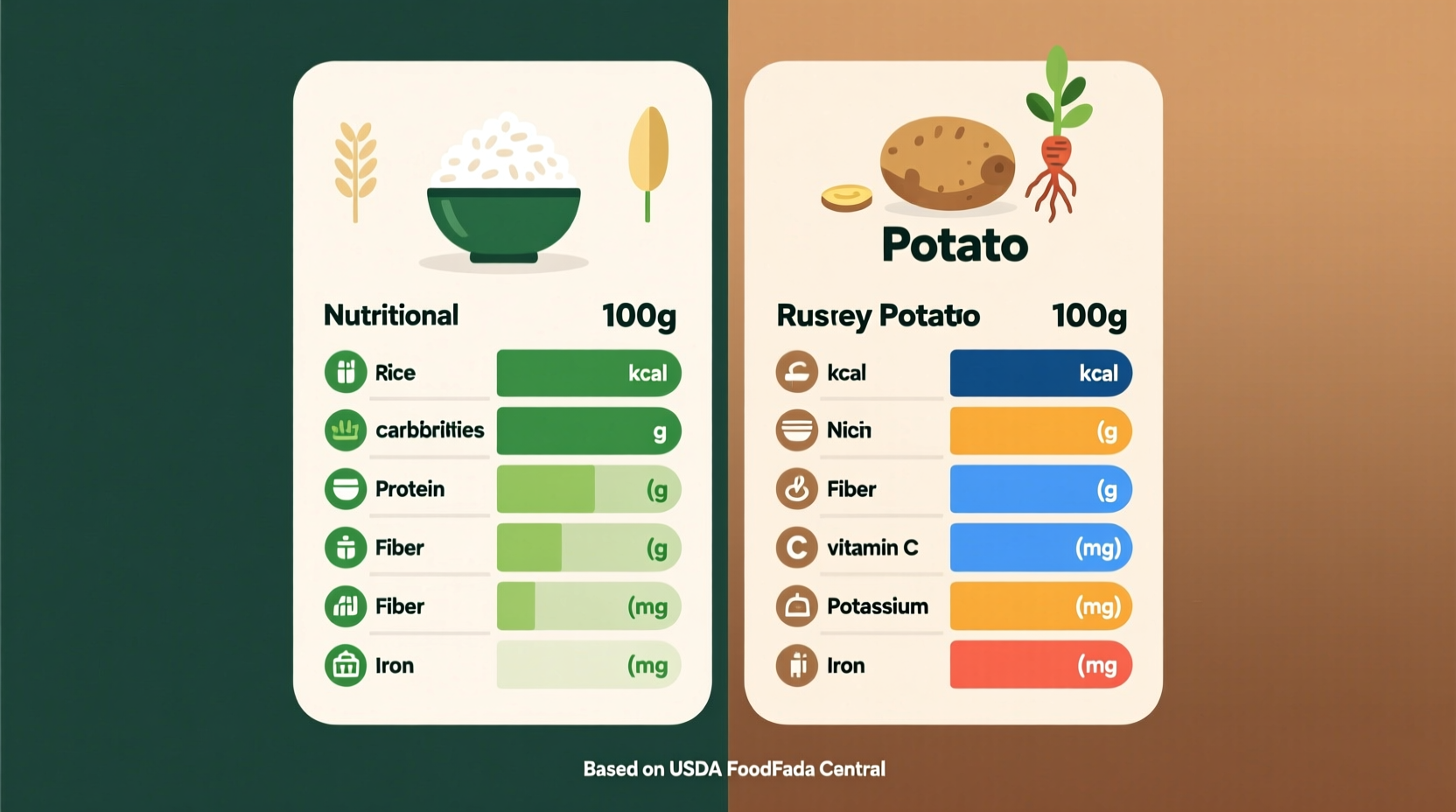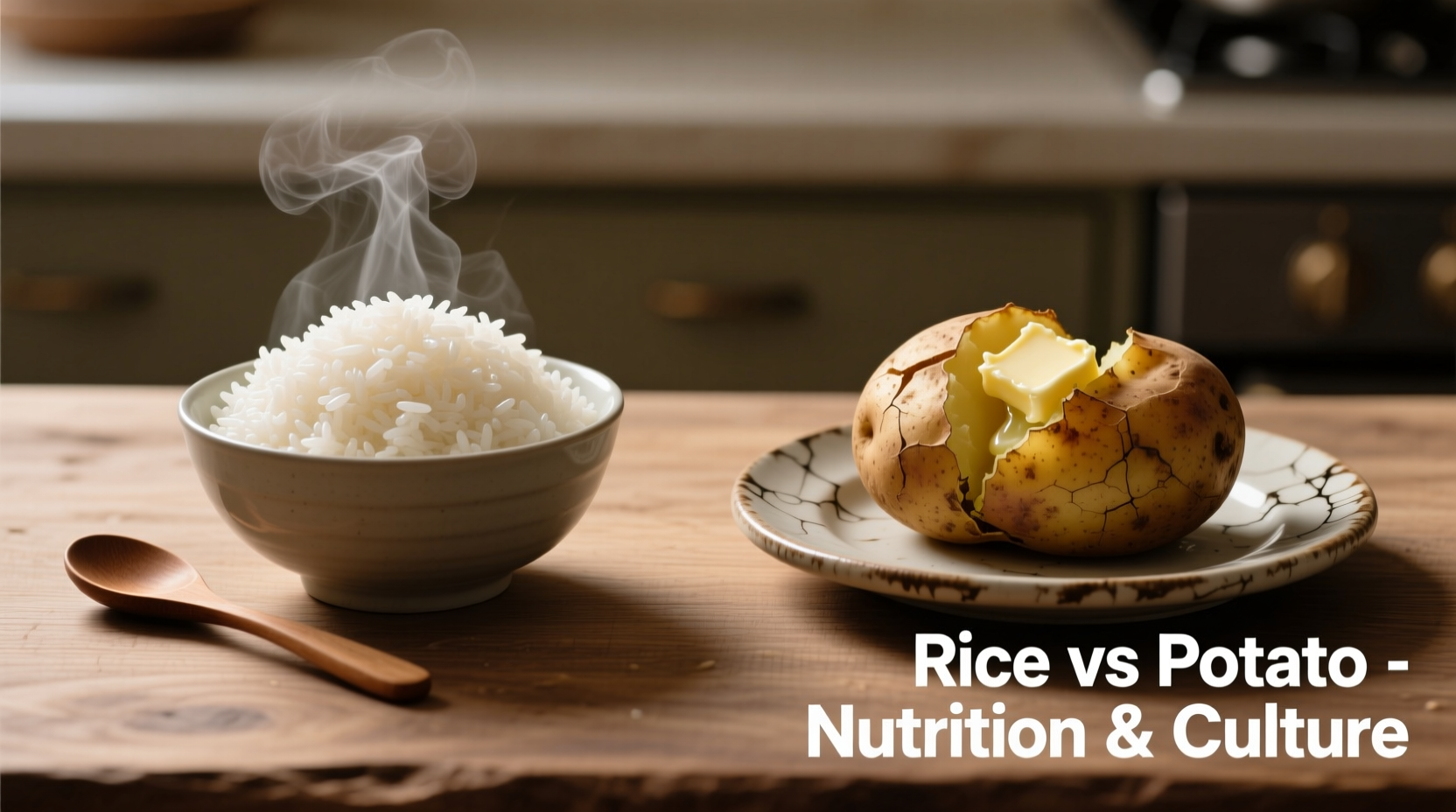When comparing rice versus potato, the nutritional winner depends on your specific dietary needs. Potatoes generally offer more vitamins (especially vitamin C and B6), potassium, and fiber, while rice provides more easily digestible carbohydrates with a lower glycemic index in its brown variety. For weight management, potatoes' higher satiety value often makes them the better choice, while rice may be preferable for those needing quick energy or managing certain digestive conditions.
Nutritional Face-Off: Breaking Down the Numbers
Understanding the nutritional differences between rice and potatoes requires examining both macronutrients and micronutrients. According to USDA FoodData Central, a 100g serving of cooked white rice contains approximately 130 calories, 28g carbohydrates, 2.7g protein, and minimal fat. The same amount of boiled potato offers 77 calories, 17g carbohydrates, 2g protein, and slightly more fiber at 2.2g.
| Nutrient (per 100g) | White Rice (cooked) | Potato (boiled, with skin) |
|---|---|---|
| Calories | 130 | 77 |
| Carbohydrates | 28g | 17g |
| Fiber | 0.4g | 2.2g |
| Vitamin C | 0mg | 19.7mg (33% DV) |
| Potassium | 35mg | 421mg (12% DV) |
| Glycemic Index | 73 (white), 50 (brown) | 78 (white), 62 (sweet) |
This nutritional comparison reveals why potatoes often win in vitamin density while rice provides more straightforward energy. The fiber content in potatoes (especially with skin) contributes significantly to their higher satiety value, making them potentially more effective for weight management despite similar carbohydrate content.
Glycemic Impact: Blood Sugar Considerations
For individuals monitoring blood sugar levels, the glycemic index (GI) becomes crucial. White rice typically has a GI of 73, placing it in the high category, while boiled white potatoes range from 72-82 depending on preparation. However, cooling potatoes after cooking creates resistant starch, lowering their effective GI to around 56. Brown rice offers a more moderate GI of approximately 50, making it a better option for blood sugar management than white varieties of either staple.
Research published in the American Journal of Clinical Nutrition demonstrates that potato consumption doesn't necessarily lead to higher blood glucose spikes than rice when portion sizes are controlled and prepared with appropriate cooking methods. The study found that when consumed as part of a balanced meal with protein and healthy fats, both staples can fit within a diabetes-friendly diet.
Culinary Applications: When to Choose Which
Your cooking application should guide your choice between rice and potatoes. Potatoes excel in dishes requiring texture contrast and moisture retention, such as stews, soups, and gratins. Their natural starch content helps thicken sauces and provides that satisfying creamy texture in mashed preparations. Rice, particularly long-grain varieties, maintains distinct grains when cooked, making it ideal for pilafs, stir-fries, and dishes where separation is desirable.
Consider these practical guidelines for your next meal:
- Choose potatoes when: You need a hearty side that pairs well with roasted meats, want to create comforting dishes like shepherd's pie, or need a base for breakfast hash
- Choose rice when: Preparing Asian-inspired dishes, creating light and fluffy side dishes, or needing a neutral base that won't overpower other flavors
- Consider sweet potatoes when: You want higher vitamin A content, need a naturally sweeter profile, or desire a lower glycemic option

Dietary Context: Matching to Your Health Goals
The "better" choice between rice and potatoes depends entirely on your specific dietary context and health objectives. For weight management, potatoes generally provide greater satiety per calorie due to their higher water and fiber content. A study from the University of Leeds found that boiled potatoes ranked highest on the satiety index—nearly seven times more filling than croissants and significantly more satisfying than white rice.
However, certain dietary restrictions may tip the balance:
- For gluten-free diets: Both are naturally gluten-free, but rice often appears in more processed gluten-free products
- For low-FODMAP diets: White potatoes are generally well-tolerated, while rice (especially white) is considered low-FODMAP in standard portions
- For kidney disease: Potatoes' higher potassium content may require restriction, making rice the preferable option
Understanding these context boundaries helps explain why nutrition recommendations vary so widely. What works for one person's dietary needs might not serve another's equally well.
Practical Considerations Beyond Nutrition
When deciding between rice versus potato, consider these practical factors that impact your daily cooking experience:
- Preparation time: White rice typically requires 15-20 minutes of cooking time, while potatoes need 20-30 minutes depending on size and preparation method
- Storage: Properly stored rice can last up to 2 years, while potatoes last 2-3 weeks at cool room temperature (but shouldn't be refrigerated)
- Cost: According to USDA Economic Research Service data, white rice averages $0.04 per serving while potatoes average $0.07 per serving, making rice slightly more economical
- Versatility: Rice works across more global cuisines without significant modification, while potatoes shine in European and American preparations
Environmental Impact Comparison
For environmentally conscious consumers, the water footprint differs significantly between these staples. Rice cultivation typically requires 2,500 liters of water per kilogram produced, compared to potatoes' 287 liters per kilogram according to Water Footprint Network data. However, potatoes have a higher carbon footprint per calorie when transported long distances due to their weight and perishability.
Local growing conditions dramatically affect this calculation. In regions where rice is traditionally grown (like Southeast Asia), its environmental impact decreases substantially compared to importing potatoes. Conversely, in temperate climates where potatoes thrive, they represent the more sustainable local option.
Making Your Choice: Practical Recommendations
Rather than declaring one universally superior, consider these evidence-based recommendations:
- For active individuals needing quick energy replenishment: White rice may be preferable due to its faster digestion
- For weight management and sustained fullness: Potatoes (especially boiled with skin) provide superior satiety
- For blood sugar management: Brown rice or cooled potatoes (for resistant starch) offer better options
- For maximum nutrient density: Sweet potatoes outperform both white rice and white potatoes
Remember that both can coexist healthfully in a balanced diet. The key is appropriate portion control and preparation methods—baking or boiling rather than frying, and keeping added fats and sodium in check regardless of which staple you choose.
Author Bio
Maya Gonzalez is a Latin American cuisine specialist who has spent a decade researching indigenous spice traditions from Mexico to Argentina. Her field research has taken her from remote Andean villages to coastal communities, documenting how pre-Columbian traditions merged with global influences. Maya's expertise in understanding how staple foods function across different cultural contexts makes her uniquely qualified to analyze the rice versus potato debate through both nutritional and cultural lenses.











 浙公网安备
33010002000092号
浙公网安备
33010002000092号 浙B2-20120091-4
浙B2-20120091-4